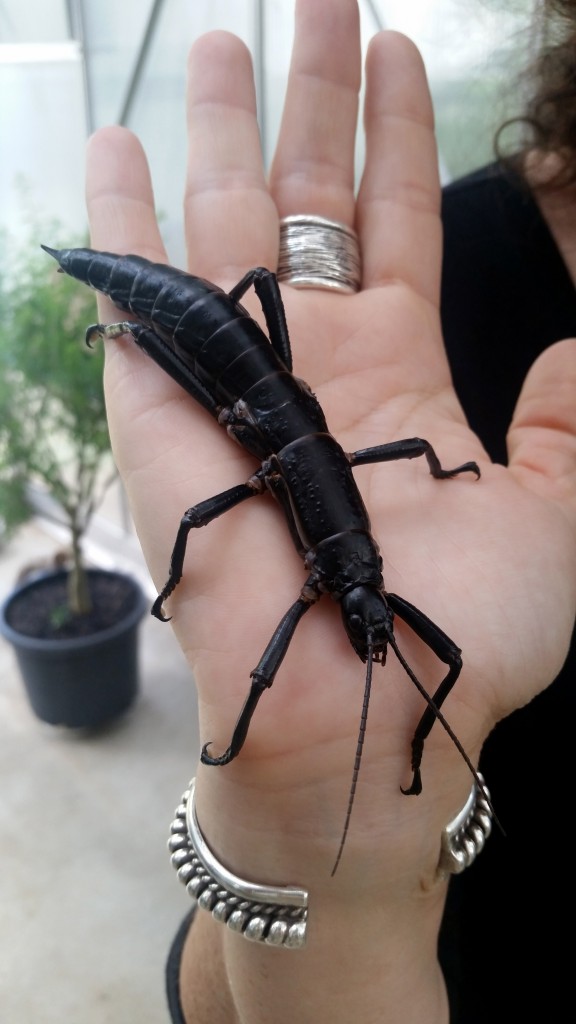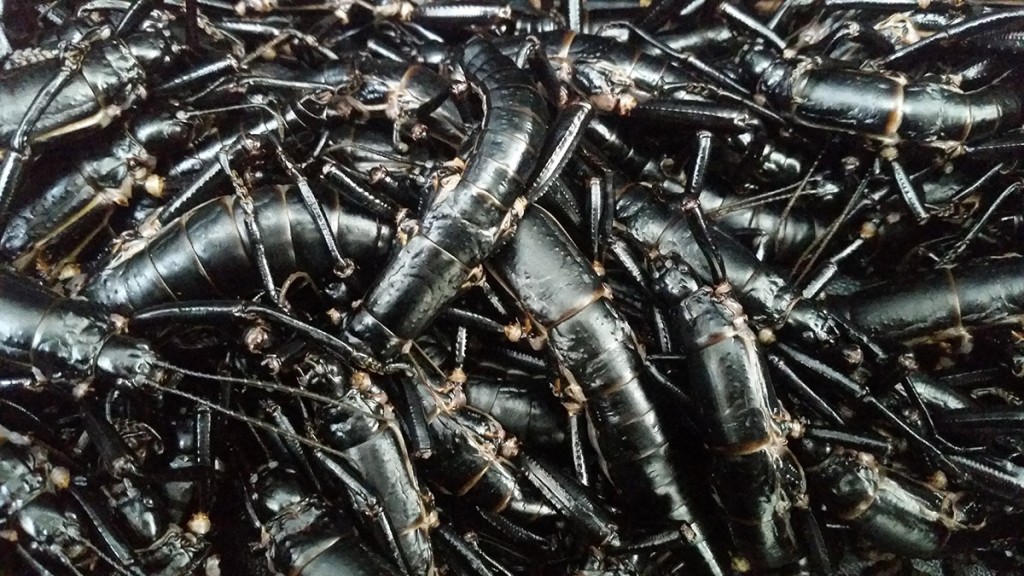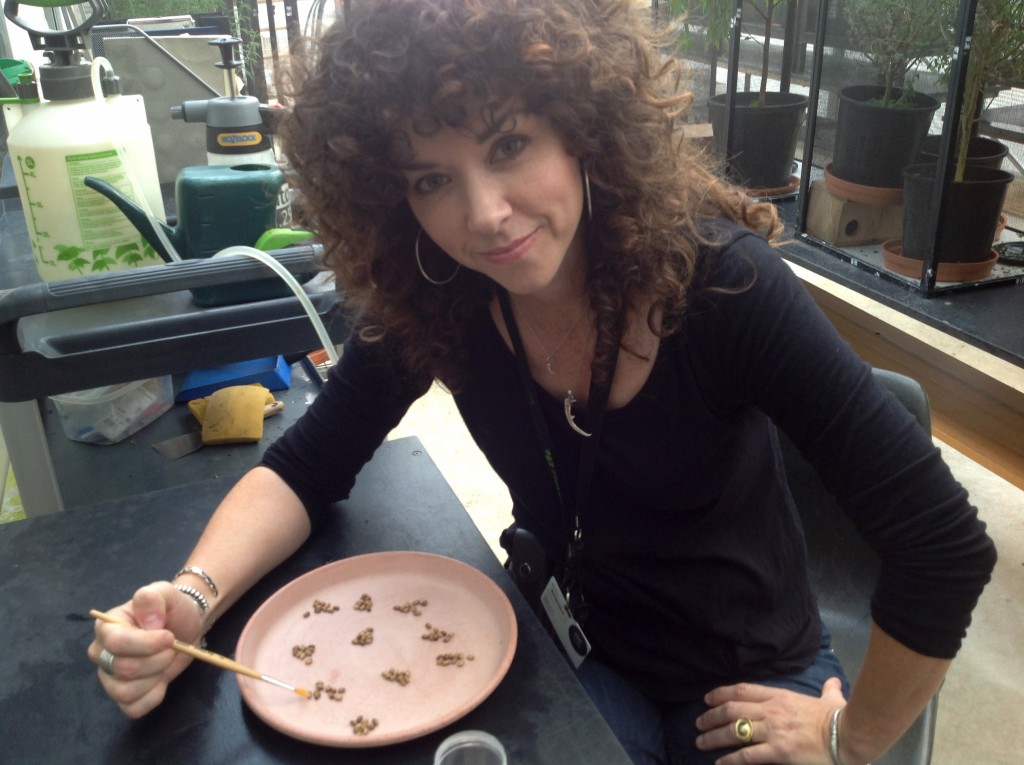It’s 8:06 am, and it’s -46 degrees Centigrade outside. At 36,998 feet, I can see dawn rising through window beside my airplane seat. It’s a welcome sight after 12 hours in the air and 7,000 miles traveled; it means that we will soon touch down in Los Angeles and begin the second leg of the journey to San Diego. My companion for this journey is a box. And it’s pretty ordinary, other than the fact that it contains 300 eggs of the most endangered insect on the planet.

Also known as tree lobsters, adult Lord Howe Island stick insects can measure seven inches long. (Photo: Rohan Cleave at Melbourne Zoo)
I have traveled to Australia to collect eggs of the critically endangered Lord Howe Island stick insect, Dryococelus australis, from my colleagues at the Melbourne Zoo, as the San Diego Zoo joins the international breeding program for this remarkable species. The story of this incredible insect bears a longer treatment than I can type out on my iPad (my laptop battery died in flight, naturally), but even the barest outline inspires wonder.
Thought extinct since the mid 1930s, this species is endemic to Lord Howe Island, a World Heritage site located 375 miles from mainland Australia. In a classic example of exotic species invasion leading to native species extinction, black rats wiped the insect off the island when a ship ran aground there in 1918. A decades-long, eerie silence followed.
In 1964, however, a remarkable discovery was made—and in an unlikely place. Ball’s Pyramid is a sharp, steep spike of volcanic rock jutting from the ocean 12 miles southeast of Lord Howe Island. Climbers on an expedition there found and photographed remnants of Lord Howe Island stick insects and insect feces. No living insects were seen, however, and the extinction status held.
Finally, in 2001, a team of Australian scientists sought to prove the existence—or extinction—of this animal once and for all. In a treacherous ascent, they climbed Ball’s Pyramid at night to search for the nocturnal stick insect. In doing so, they found a few individuals feeding on a stunted bush; and just like that, the species was resurrected.

Lord Howe Island stick insects are nocturnal; during the day dozens of adults huddle in tree hollows to hide from predators. At Melbourne Zoo, nest boxes are provided to encourage this behavior. (Photo taken at Melbourne Zoo)
In 2003, 4 adult specimens were collected from the small group of less than 30 or so living on Ball’s Pyramid. Two went to a private breeder and two went to Melbourne Zoo. From this initial effort, the species has been rescued from certain extinction. This year, Melbourne Zoo celebrated its 12th generation and 13,000th hatchling of the program. At any given time, however, the population in Melbourne hovers around 600 animals.
The San Diego Zoo, along with Bristol Zoo in the United Kingdom and Toronto Zoo in Canada, will serve as a safety net for this program while the reintroduction of the stick insect to Lord Howe Island awaits. If a catastrophic event were to affect the colony at Melbourne Zoo, the species would be devastatingly close to extinction once again. Thus, assurance colonies are critical. With the success of each breeding program, the security of this animal is increased and the thin margin between recovery and extinction expanded.

The author in Melbourne, carefully preparing eggs for the journey to the San Diego Zoo. (Photo: Rohan Cleave at Melbourne Zoo)
Before I left Melbourne, I was asked in a radio interview, “Why does the San Diego Zoo care about stick insects; why come all this way?” The answer is simple: this species has fought for its place in this world. It somehow survived an introduced predator and a possible translocation to a barren habitat where few life forms sustain their existence. It persisted for decades on an exposed seamount, likely adapting to novel host plants and extreme conditions. Don’t we owe the Lord Howe Island stick insect the best effort we have? We are committed to fighting extinction, and this species is as valuable as any other. Indeed, animals in every ecosystem owe some part of their existence to the survival of invertebrates.
Back in San Diego, once the eggs are set up in their dedicated breeding room, their immediate future will be in the capable hands of our zoo invertebrate specialist team. In the bigger picture, there are plans to eradicate the rats on Lord Howe Island to allow these animals to have a safe home to return to.
As the sole US institution entrusted with the care of this species, the San Diego Zoo feels honored to be able to share the Lord Howe Island stick insect story in this country. We hope their remarkable struggle for survival will be a reminder that imperiled species come in all sizes and taxonomic categories, and that entire species can slip away while no one is watching.
And now, another in-flight movie. The very surreal observation that these sacred eggs are sitting silently beside me as I watch The Martian, The Godfather, and maybe a couple of episodes of Veep has not escaped me. But compared to the epic, historical journey this species has already undertaken, what’s another 8,000 miles?
Paige Howorth is the Associate Curator of Entomology at the San Diego Zoo. Read her previous blog, It’s (Almost) Black Tuesday for Bees.





